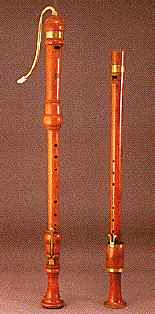Recorders and wind instruments
Shrill, eerie, or courtly: wind instruments had a sound for every season.
The gentle sound of the recorder made it a welcome addition to banquets in the homes of the aristocracy. Hamlet's court musicians certainly had them*, though the travelling players preferred the martial, audience-silencing trumpet. Also martial was the fife; Benedick in Much Ado About Nothing compares the pipe, used in dancing, unfavourably with the fife*.
Early oboes* (hautboys--the name in French means "high wood") were used for eerie effects: the odd and seemingly supernatural music (under the stage) that the soldiers in Antony and Cleopatra hear before the final battle (4.3.11). In Macbeth, the final apparition of the witches is accompanied by the assertive music of the hautboy (4.2.88).
The instruments
On the left is a seventeenth century bass recorder; on the right a somewhat earlier recorder, also a bass, though of a somewhat higher pitch. Note that each has one key to allow for the lowest note on the instrument.
Listen to a consort of recorders*.
Footnotes
-
Hamlet and a recorder
Hamlet uses a recorder to demonstrate to Rosencrantz and Guildenstern the hubris of their attempts to manipulate him. When Guildenstern says he cannot play the recorder, Hamlet responds:
Why, look you now, how unworthy a thing you make of me! You would play upon me; you would seem to know my stops; you would pluck out the heart of my mystery; you would sound me from my lowest note to the top of my compass. . . 'Sblood, do you think I am easier to be played on than a pipe?
(3.2.371-78). -
A change of instruments
Benedick compares Claudio's former martial self with his new role as lover, by referring to the different instruments he favours: "I have known when there was no music with him but the drum and the fife; and now had he rather hear the tabor and the pipe" (Much Ado About Nothing, 2.3.12-13). The tabor and pipe were played by one person--see the illustration of the musician accompanying the clown Will Kempe.
-
Screaming shawms
The more rustic predecessor to the hautboy was the shawm. Listen to the recreation of the bagpipe-like sound of shawms in two arrangements of popular dances by Curtis Clarke: a "Volte" by Michael Praetorius, from Terpsichore,
and an anonymous "Pavane."
-
Spiritual music
The music here is an instrumental version of Robert Johnson's setting of Ariel's song "Where the Bee Sucks" in The Tempest. Go to the page where you can listen to it sung.
